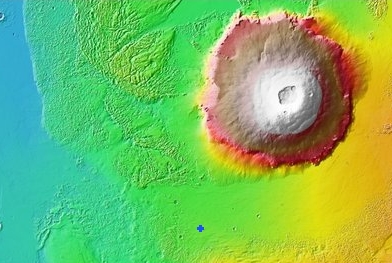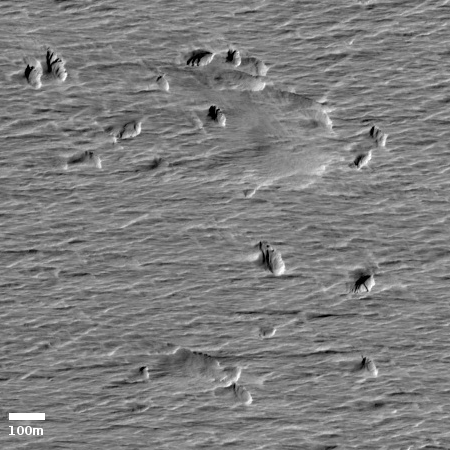Sinkholes galore!
Cool image time! The photograph to the left, cropped to post here, was part of the November image dump from the high resolution camera on Mars Reconnaissance Orbiter (MRO). It shows a wind-swept dusty plain trending downhill to the west that is filled with more than a hundred depressions or sinkholes.
Unlike other pit images I have posted previously, this one is not focused on one particular pit or a string of pits. Instead, what makes it interesting is the large number of pits, scattered across the terrain in a random pattern. Their random distribution suggests that they are unrelated to any specific underground feature, such as a lava tube. Instead, some aspect of the underground geology here is causing the ground to sink at random points.
Below is an overview map showing where this dusty pit-strewn plain is located, indicated by the blue cross.

South of the solar system’s largest volcano, Olympus Mons, this region is part of of the transition zone between the Tharsis Bulge where Mars’ giant volcanoes are located, down to northern lowland plains, shown in blue to the west.
I do not know whether these pits formed from volcanic activity or some underground erosion process. At a latitude of only 9 degrees north the presence of abundant underground water is unlikely, though not impossible. Yet, the pits might be very old, formed at a time when Mars’ climate was wetter and the transition zone was a region where liquid water might have intermittently ebbed and flowed across the terrain.
All speculation. I just like the weirdness of this pitted plain.
On Christmas Eve 1968 three Americans became the first humans to visit another world. What they did to celebrate was unexpected and profound, and will be remembered throughout all human history. Genesis: the Story of Apollo 8, Robert Zimmerman's classic history of humanity's first journey to another world, tells that story, and it is now available as both an ebook and an audiobook, both with a foreword by Valerie Anders and a new introduction by Robert Zimmerman.
The print edition can be purchased at Amazon or from any other book seller. If you want an autographed copy the price is $60 for the hardback and $45 for the paperback, plus $8 shipping for each. Go here for purchasing details. The ebook is available everywhere for $5.99 (before discount) at amazon, or direct from my ebook publisher, ebookit. If you buy it from ebookit you don't support the big tech companies and the author gets a bigger cut much sooner.
The audiobook is also available at all these vendors, and is also free with a 30-day trial membership to Audible.
"Not simply about one mission, [Genesis] is also the history of America's quest for the moon... Zimmerman has done a masterful job of tying disparate events together into a solid account of one of America's greatest human triumphs."--San Antonio Express-News
Cool image time! The photograph to the left, cropped to post here, was part of the November image dump from the high resolution camera on Mars Reconnaissance Orbiter (MRO). It shows a wind-swept dusty plain trending downhill to the west that is filled with more than a hundred depressions or sinkholes.
Unlike other pit images I have posted previously, this one is not focused on one particular pit or a string of pits. Instead, what makes it interesting is the large number of pits, scattered across the terrain in a random pattern. Their random distribution suggests that they are unrelated to any specific underground feature, such as a lava tube. Instead, some aspect of the underground geology here is causing the ground to sink at random points.
Below is an overview map showing where this dusty pit-strewn plain is located, indicated by the blue cross.

South of the solar system’s largest volcano, Olympus Mons, this region is part of of the transition zone between the Tharsis Bulge where Mars’ giant volcanoes are located, down to northern lowland plains, shown in blue to the west.
I do not know whether these pits formed from volcanic activity or some underground erosion process. At a latitude of only 9 degrees north the presence of abundant underground water is unlikely, though not impossible. Yet, the pits might be very old, formed at a time when Mars’ climate was wetter and the transition zone was a region where liquid water might have intermittently ebbed and flowed across the terrain.
All speculation. I just like the weirdness of this pitted plain.
On Christmas Eve 1968 three Americans became the first humans to visit another world. What they did to celebrate was unexpected and profound, and will be remembered throughout all human history. Genesis: the Story of Apollo 8, Robert Zimmerman's classic history of humanity's first journey to another world, tells that story, and it is now available as both an ebook and an audiobook, both with a foreword by Valerie Anders and a new introduction by Robert Zimmerman.
The print edition can be purchased at Amazon or from any other book seller. If you want an autographed copy the price is $60 for the hardback and $45 for the paperback, plus $8 shipping for each. Go here for purchasing details. The ebook is available everywhere for $5.99 (before discount) at amazon, or direct from my ebook publisher, ebookit. If you buy it from ebookit you don't support the big tech companies and the author gets a bigger cut much sooner.
The audiobook is also available at all these vendors, and is also free with a 30-day trial membership to Audible.
"Not simply about one mission, [Genesis] is also the history of America's quest for the moon... Zimmerman has done a masterful job of tying disparate events together into a solid account of one of America's greatest human triumphs."--San Antonio Express-News



I remember as a lad my father driving us around the Shropshire/Yorkshire dales, and pointing out the sinkholes as we past them, and also showing me as we were walking across the landscape… Some he would let me gaze into , seemingly descending into the depths of the earth, others just a crater, sometimes filled with rubble…
Yet others he would warn me to keep away from the edge, presumably as it was unstable…. They call the area “limestone country”, and almost all are caused by the erosion of the more easy dissolved limestone around harder rock.
Sorry to reiterate what most here know!
Some terrestrial images show the distinct path of underground water, but images like the above fill my mind with alien processes that could perhaps cause such a random scattering of pits …. If only we can discover WHY in our lifetime…
https://www.bgs.ac.uk/research/engineeringGeology/shallowGeohazardsAndRisks/sinkholes/home.html
This link is a good infographic on the causes of these pits here on earth.